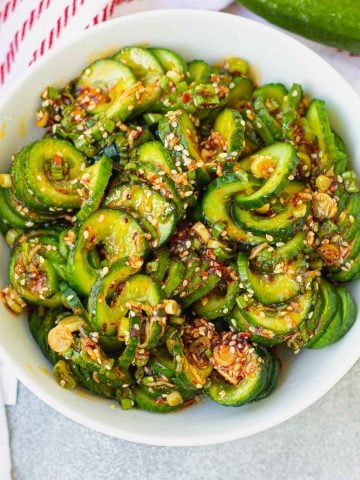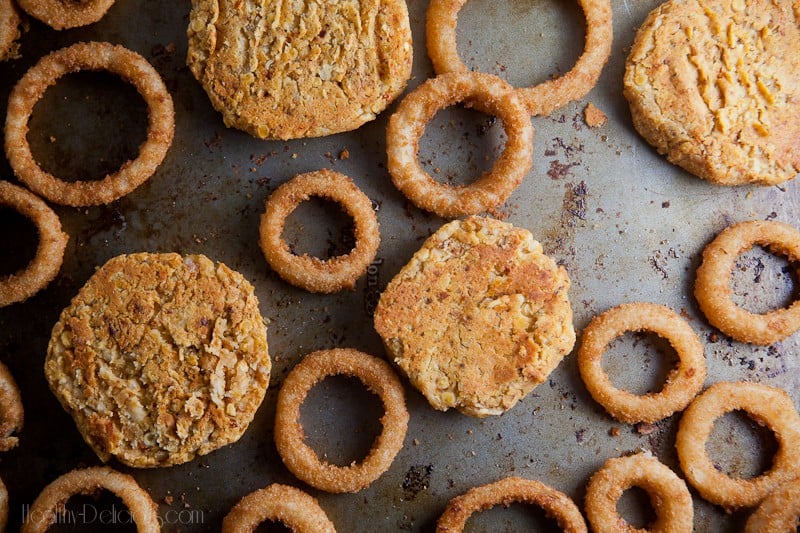Korean Barbecue Steak Rice Bowls (Paleo/Whole 30 option)
Korean Barbecue Steak Rice Bowls are topped with mouthwatering steak marinated in garlic, ginger, sesame oil, and chili paste, spicy kimchi, and fresh vegetables. Make it with cauliflower rice for a paleo/Whole 30 option!
This post was sponsored by the New York Beef Council.
Have you even eaten a steak that was so good you wanted to cry? I’ve been lucky enough to experience that two times in the last month. The first was a gorgeous porterhouse steak that we seasoned with simple steak seasoning and grilled. The second was this Korean barbecue steak. With a little know-how, you’ll be well on your way to a fabulous steak experience, too! But more on that later.
First up, let’s talk about these Korean Barbecue Steak Rice Bowls. They’re quick and easy to make, but they’re so delicious. I love rice bowls like this because you can pick one main feature – in this case a flavorful Korean barbecue steak – and then use whatever odds and ends you happen to have in the fridge.
I loaded these Korean barbecue bowls up with kimchi, cucumber, carrot, jalapeno peppers, and scallions. You can also add sautéed or grilled peppers and onions, mushrooms, spinach, or even zucchini. They’re great for using up leftovers! And you can easily make them paleo/Whole 30 complaint by swapping out the white rice for cauliflower rice.
How to select the best cuts of meat
A few weeks ago I joined a representative from the New York Beef Council for a “meat counter tour.” I’ve been on farm tours with them before, but this time was different. We visited a local butcher shop and they walked us through the different cuts of beef that are available. They also gave us some helpful hints about how to know which cuts can be swapped in for each other and how to know how each cut should be cooked (for example, grilled versus slow cooked.)
Then, they challenged us to pick a cut of beef we weren’t familiar with and use it in a new recipe. I chose the flat iron steak that you see in these bowls. Flat iron is a relatively new cut of steak; I’ve heard of it before but never tried cooking it myself. It’s second in tenderness only to tenderloin/filet and it practically melts in your mouth.
One of the things that the New York Beef Council was able to clarify is what the deal with marbling is. You always hear people talking about a well-marbled steak, but what does that really mean and how important is it? It turns out it has a lot to do with how tender and flavorful the steak is. The red part of the meat really doesn’t have any flavor – it all comes from the marbling that runs throughout. Don’t worry – marbling on the inside of the steak doesn’t taste fatty or gristly. It melts as the steak cook and gives it tons of flavor. Marbling is also how meat is graded – prime has the most and will be juiciest and most flavorful, select is leaner but needs to be marinated or its pretty blah, choice (what you find most commonly in grocery stores) is in the middle. Nutritionally, that means a prime steak will have more fat than a select cut – but it also means you don’t need to add an oily marinade or cooking sauce. Grass fed beef is a great option, but prime grade grass fed beef doesn’t exist – it simply can’t get enough marbling.
It’s also really important to look at your labels. Butcher shops and grocery stores can get tricky! For example, this flat iron steak was sold as “Fred’s favorite” at the butcher shop we visited. You wouldn’t know it was flat iron unless you’re savvy about meat – or you asked. It’s all simple marketing – they want you to come back, so they make it seem like something special that you can only get there. On the other end of the spectrum, some stores will give select grades of meat “fancy” names and you might not notice that it’s select unless you look closely. Select is still good, but you need to know what to do with it or it can be pretty disappointing (I speak from experience.)
In terms of tenderness, there are a few factors at play. The first is marbling – the more marbling there is, the more tender your steak will be. You can also think about where on the cow the cut comes from. Cuts from the front and back end, like chuck, shank, and round are taken from muscles that do a lot of work, so they tend to be tougher and benefit from slow cooking times and a moist environment (think slow cooker red wine beef) while cuts from the middle of the cow like the loin and flank don’t get as much exercise so they’re tender. Think of it like this: cows have a lot of leg days, but they’re not exactly doing crunches. Different cuts from the same section can usually be swapped out for each other. For example, instead of flat iron you could use shoulder steak or top blade steak for these Korean barbecue steak rice bowls. Here’s a super handy pdf that helps make sense of it all. You can also visit beefitswhatsfordinner.com for loads of recipes and helpful tips on how to cook specific cuts.

Ingredients
- 2 Tablespoons coconut aminos
- 1 Tablespoon chili paste
- 1 Tablespoon grated ginger
- 1 Tablespoon honey
- 1 Tablespoon sesame oil
- 2 garlic cloves
- 1 generous pinch sea salt
- 1.5 pounds flat iron steak
- 1 Tablespoons sesame seeds
- 2 cups cooked white rice or cauliflower rice
- 2 carrots sliced
- ½ seedless cucumber sliced
- ½ cup kimchi
- 3 scallions sliced
- 1 jalapeno pepper sliced (optional)
- Chili paste for serving optional
Instructions
- In a shallow dish, combine the coconut aminos, chili paste, ginger, honey, sesame oil, garlic, and salt. Mix well. Add the steak and turn to coat. Marinate 20 minutes.
- Meanwhile, heat your grill or a grill pan to high heat; cook for 5-7 minutes on each side, as desired. Remove from the grill and let rest 10 minutes. Sprinkle with sesame seeds and slice thinly across the grain.
- Divide the cooked rice between 4 bowls. Top with steak, carrot and cucumber slices, kimchi, scallions, and jalapeno slices. Serve with chili paste, if desired.














These look delicious!
Cooked to perfection!!
What a beautifully colorful meal! I love it when a dish has great flavor and visual appeal!